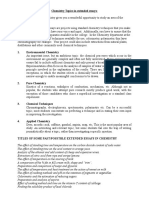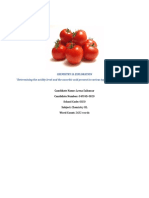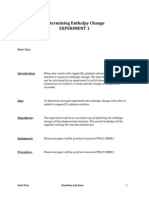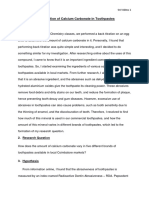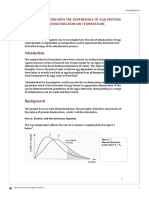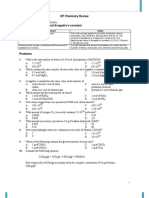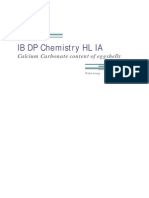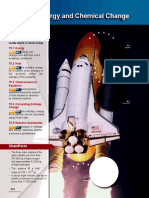IB Chemistry IA: Energetics
IB Chemistry IA: Energetics
Uploaded by
Momina AmjadCopyright:
Available Formats
IB Chemistry IA: Energetics
IB Chemistry IA: Energetics
Uploaded by
Momina AmjadCopyright
Available Formats
Share this document
Did you find this document useful?
Is this content inappropriate?
Copyright:
Available Formats
IB Chemistry IA: Energetics
IB Chemistry IA: Energetics
Uploaded by
Momina AmjadCopyright:
Available Formats
Calculating Enthalpy of Combustion for the First Five Alcohols
Momina Amjad
Background Information:
The heat produced when one mole of a substance is burned in excess oxygen is called the enthalpy of
combustion. Methanol, ethanol, propanol, butanol and pentanol all belong to one homologous series;
alcohols, with the functional group OH. They have hydrogen bonds (specific kind of permanent dipole-
dipole forces) and van der Waals forces which increase as the length of the carbon chain increases.
Complete combustion of alcohols produces carbon dioxide and water. An example of the reaction for
enthalpy of combustion is given below:
C2H5OH (l) + 3O2 (g) 2CO2 (g) + 3H2O (g)
For this reaction, the IB data booklet value (standard enthalpy change of combustion) is -1367 kJ mol
-1
which shows that this reaction is exothermic.
Research Question:
What effect does the length of the carbon chain have on the enthalpy of combustion in primary
alcohols?
Hypothesis:
The longer the carbon chain is in an alcohol, the greater its enthalpy of combustion is going to be.
Variables:
Independent Variable:
Length of the carbon chain of the alcohol.
Dependent Variable:
Mass of the alcohol burned.
Controlled Variables:
1. The temperature increase in water
2. The mass of the water in the calorimeter
3. Apparatus used
4. The temperature and pressure of surroundings
5. The distance between the calorimeter and the burner
Method of control:
The independent variable is manipulated by changing the fuel in the burner each time to a different
alcohol. For the controlled variables, temperature increase in water is set to be 30C, after which the
burner is to be removed to measure the change in mass on a balance. The mass of water is always 100
grams in the calorimeter. The same calorimeter, thermometer, balance and shape and type of burner
are used each time. The temperature of the surroundings is maintained via air conditioning in the lab.
The distance between calorimeter and burner is measured by a ruler.
Apparatus:
Balance (0.01 g)
Thermometer (0.1 C)
Aluminum calorimeter
Burners (Spirit lamps)
Wind shields
Clamps and stands
Materials:
Methanol, ethanol, propanol, butanol and pentanol in the spirit lamps
Match sticks
Distilled water
Wipes
Net Uncertainties (accounting for initial and final measurements if applicable)
Balance (for fuel) 0.02 g
Balance (for water) 0.01 g
Thermometer 0.2 C
Procedure:
1. Measure a 100g of water and put it in the calorimeter clamped to a stand.
2. Fix wind shields on the clamps with the stands and place them so that the calorimeter is
shielded from three sides.
3. Measure the initial mass of fuel, starting from methanol in the spirit burner. Its important to
note that the lid should be closed; otherwise some of the fuel will vaporize and escape. Write
down the initial mass.
4. Place a thermometer in the water and note down the initial temperature
5. Open the lid of the burner and light it. Immediately after that, place it under the calorimeter
with water.
6. Stir the water frequently using the thermometer while its being heated. This is to ensure that
heat in transferred to the water as evenly as possible.
7. The thermometer is inserted the whole time. Keep reading the thermometer until there is an
increase of 30C, and note down any qualitative changes during that time.
8. Once there has been a temperature increase of 30C, remove the burner, place the lid back on
and measure its mass again. This has to be done swiftly, in order to minimize the amount of fuel
escaping the burner.
9. Write down the final mass of the burner, and repeat steps 1 to 8 with all of the other 4 alcohols.
10. Repeat this whole experiment with all 5 alcohols at least two more times so there are three
trials over all.
Risk Assessment:
Alcohols are not corrosive or harmful to the skin but they must not be ingested. For safety, wear goggles
and a lab coat throughout. Use a pair tongs to handle the hot calorimeter when adding or removing
water again. Inform the teacher or a lab assistant immediately in case of a fire or a burn.
Photographs of the setup & apparatus:
0.1 C thermometer
inserted in heating
water to control the
temperature rise to
only 30C
Same aluminium
calorimeter used
each time
Wind shields to
protect the flame
from gusts of wind
and keep it steady
Clamp and
stands
Butanol burner
Data Collection:
Masses of the alcohols before and after being used as a fuel to heat 100g water by 30C
Trial 1 Trial 2 Trial 3
Alcohol Initial mass/g
0.01
Final mass/g
0.01
Initial mass/g
0.01
Final mass/g
0.01
Initial mass/g
0.01
Final mass/g
0.01
1. Methanol
154.01 152.73 152.21 150.95 150.07 148.93
2. Ethanol
152.14 150.87 151.29 150.22 149.10 147.94
3. Propanol
181.41 180.64 180.54 179.78 179.72 178.92
4. Butanol
173.64 172.84 172.80 172.08 171.95 171.25
5. Pentanol
169.25 168.74 168.69 168.00 167.90 167.25
Table 1: Raw Data Table
Qualitative analysis:
The flame for each of these fuels and trials was always yellow at the top.
Black soot formed at the base of calorimeter at all times, but it got noticeably thicker and darker
the higher the carbon chain of the alcohol was used.
The burners themselves got warmer while they were heating up water. In some cases
condensation droplets were visible on the inner surfaces as seen a photograph above.
0.01 precision Digital
balance used all times
Yellow flame; same
distance between
flame and calorimeter
was maintained
Droplets of fuel
formed on inner
surface of the burner
Although time wasnt a controlled variable in this experiment, the amount of time it took to
raise the water by 30C increased each time the carbon chain length was increased. This was
perceptible even without the use of a timer.
Data processing:
The data above needs to be processed in order to draw meaningful results out of it. First of all, change
of mass needs to be calculated. Since there were three trials in this experiment, its best to take a mean
of the mass change.
In this experiment, it is assumed that the heat change of the reaction is equal to the heat change of
water i.e. all the energy lost by the fuel while its burning is transferred to the water. Under this
assumption, the following is an expression that can be used:
Heat change of reaction= heat change of water
=mH2OcH2O H2O
Where m is the mass of water, c is the specific heat capacity of water and is the temperature change
of water. Enthalpy of combustion is measured in kJmol
-1
therefore this value is divided by the number of
moles of the fuel and 1000. The sample calculation for methanol for all of the above is done here.
Change in mass: 154.01-152.73=1.28 g, 152.21-150.95=1.26 g, 150.07-148.93=1.14 g
Mean change in mass= 1.23 g
Number of moles of methanol= mass/molar mass= 1.23/(12.01+3.03+17.01)= 0.04 mol
Heat change in water= = 100 4.18 50= 20900 Joules
Heat change of the reaction=20900/0.04= -546069.29 Jmol
-1
= -546.07 kJmol
-1
(A negative sign is added at the end because combustion is always an exothermic reaction)
Alcohol Trial
Change in
mass/ g
0.02
Mean
change in
mass/ g
0.02
No. of
moles of
alcohol
Heat
change of
water/ J
Enthalpy of
combustion/
Jmol
-1
Enthalpy of
combustion/ kJmol
-1
1.Methanol
1 1.28
1.23 0.04 20900.00 -546069.29 -546.07 2 1.26
3 1.14
2. Ethanol
1 1.27
1.17 0.03 20900.00 -825490.29 -825.49 2 1.07
3 1.16
3. Propanol
1 0.77
0.78 0.01 20900.00 -1617552.36 -1617.55 2 0.76
3 0.80
4. Butanol
1 0.80
0.74 0.01 20900.00 -2093954.05 -2093.95 2 0.72
3 0.70
5.Pentanol
1 0.51
0.62 0.01 20900.00 -2988248.11 -2988.25 2 0.69
3 0.65
Table 2: Processed data table
Total percentage uncertainty:
Percentage uncertainty= (
net uncertainty
measured value
) 100%
The net uncertainties for mass of water, temperature and mass of fuel were mentioned above, and can
be summarized in the following expression respectively for 100g water and 30C temperature rise. The
mass of fuel varies so its given the variable . The total percentage uncertainties for each fuel is
calculated overleaf.
0.01
100
100 +
0.2
30
100 +
0.02
100
= (0.68 +
2
) %
Mean mass of the fuel
used/g 0.02
Percentage uncertainty
of fuel used
Total percentage
uncertainty
1. Methanol 1.23 1.63 % 2.31 %
2. Ethanol 1.17 1.71 % 2.39 %
3. Propanol 0.78 2.58 % 3.26 %
4. Butanol 0.74 2.70 % 3.38 %
5. Pentanol 0.62 3.24 % 3.92 %
Table 3: Calculations of total percentage uncertainty
Absolute uncertainty:
Absolute uncertainty can be calculated by multiplying the total percentage uncertainty to the enthalpy
of combustion of the fuel in kJ mol
1.
In the case of methanol,
-
2.31
100
546.07= -12.6142 kJ mol
1
is the maximum amount of methanol that can be more or less than
the value written in table 2 (-546.07 kJ mol
-1
)
Absolute uncertainty / kJ mol
-1
1. Methanol -12.61
2. Ethanol -19.73
3. Propanol -52.73
4. Butanol -70.78
5. Pentanol -117.14
With all of the data processed above, a line graph can be produced to show the relationship and trend
between the increasing carbon chain length in an alcohol and its enthalpy of combustion, both in terms
of this experiments values and data book values.
Conclusion:
The enthalpy of combustion of an alcohol increases as the carbon chain length increases. The graph
produced a downward sloping line because enthalpy of combustion values are negative; the higher the
negative value, the greater the enthalpy of combustion. This conclusion is in agreement with the
hypothesis and the trend given above, except that the experimental results didnt show a linear increase
in enthalpy of combustion.
The final values of enthalpy of combustion in ascending order of carbon chain are -546.07 kJmol
-1
, -
825.49 kJmol
-1
, -1617.55 kJmol
-1
, -2093.95 kJmol
-1
and -2988.25 kJmol
-1
. The differences in these values
again describe that the increase is not linear, i.e. close to equal between the alcohols. Percentages of
total uncertainty were different for each alcohol as well. The bigger the carbon chain length was, the
greater uncertainty was produced, ranging from 2.31% for methanol to 3.92% for pentanol. This is
because mean change in mass before and after using pentanol for heating water was only 0.62 g
whereas the mean change in mass of methanol was nearly double that amount; at 1.23 g.
-3500
-3000
-2500
-2000
-1500
-1000
-500
0
0 1 2 3 4 5 6
E
n
t
h
a
l
p
y
o
f
c
o
m
b
u
s
t
i
o
n
k
J
m
o
l
-
1
Carbon chain length
The enthalpy of combustion of methanol, ethanol,
propanol, butanol and pentanol
Experimental value
Data book value
Experimental value: line of best
fit
The principal reason for these observations is that increasing the carbon chain length increases the size
of the molecule significantly, The molecular formula of methanol is CH3OH, ethanol is C2H5OH, and
propanol is C3H7OH and so on. Increase in one carbon atom results in two more hydrogen atoms and
over all 3 more sigma bonds on the carbon atoms. The molar mass of methanol is 32 g mol
-1
and theres
an increase of 14g each time a carbon atom (and consequently two hydrogen atoms) are added.
Increase in molecular mass greatly affects van der Waals forces (temporary and weak intermolecular
forces). Its harder to break bigger carbon chain molecules because it takes longer to break these
intermolecular bonds. This was observed in the qualitative data above, methanol raised the
temperature of water fairly quickly, but pentanol took a lot of time. Apart from van der Waals forces, all
alcohols also contain hydrogen bonds which are the strongest intermolecular force, but these are
present equally in all primary alcohols.
The experimental values produced as a result of this investigation can be compared to standard
enthalpy of combustion values. The dotted red line on the graph on the previous page represents
standard values taken from the IB data booklet; these are higher than the experimental values. The
percentage error is a measure of how close the experimental value is to the data book value.
Percentage error= (
data book valueexperimental value
data book value
) 100
Data book value/ kJmol
-1
Experimental value/ kJmol
-1
Percentage error
1. Methanol
-726 -546.07 24.78 %
2. Ethanol
-1367 -825.49 39.61 %
3. Propanol
-2021 -1617.55 19.96 %
4. Butanol
-2676 -2093.95 21.75 %
5. Pentanol
-3329 -2988.25 10.24 %
Table 4: Percentage error calculations
Evaluation:
The large percentage error calculated in the previous page indicates that this experiment has some
flaws. The set up itself was well designed for gathering data, and it was simple to replicate. The number
of trials should be a minimum of 5 to make any proper judgment, and this wasnt possible due to time
constraints. The main flaw of this experiment, however, is its core assumption that all the heat produced
by the combustion is transferred to the water when in fact there are many heat losses to the
surroundings.
Heat losses form the majority of the percentage error. Theres no insulation on the calorimeter and no
insulating card covering the calorimeter and retaining the heat inside. As a result, a lot of the heat
escapes from the water and is lost to the surroundings. Some of the heat is also absorbed by the
calorimeter itself. The experiment doesnt take this into account and doesnt involve calculations of heat
gained by aluminium when that could have been calculated (using equation) and
subtracted from the heat produced by fuel as a more accurate representation of the heat transferred to
water.
One of the other for this large percentage error is the incomplete combustion of the fuel that was noted
above in the qualitative analysis (yellow flame and formation of soot). This was because the fuel didnt
receive enough oxygen to burn completely and indicates that the fuel was used inefficiently because
incomplete combustion releases less energy compared to complete combustion.
The uncertainties of the equipment were not too large as noted above in table three. The uncertainty
increased as the carbon chain length increased but it still has far less an effect on the outcome of the
experiment when compared to heat losses to the environment.
Its significant that the percentage error for the alcohols isnt similar to each other (largest percentage
error was ethanol at 39.61% and the smallest was methanol at just 10.24%). This indicates that the
conditions of the surroundings, specifically the temperature, werent controlled effectively. Although an
air conditioner was used throughout the experiment at a constant temperature, it wasnt enough as the
lab door would open sometimes and the heat and sunlight outside changed frequently.
Theres also a possibility of random errors in this experiment, and errors that took place due to reaction
time in looking out for temperature rise, closing the lid of the fuel as soon as it reaches 30C and
weighing it immediately. These errors, however, are much harder to evaluate properly and control.
Improvements:
Improvement How it enhances the investigation
1. Using insulation such
as air foam around the
calorimeter
Minimizes one of the sources of heat loss
2. Insulating card to
cover the water
Retains the energy inside the heating water rather than letting it escape to
the surroundings
3. Use of a copper
calorimeter and
calculations regarding
heat absorbed by
calorimeter itself
Copper is a better conductor of heat compared to aluminum. If heat energy
gained by copper is calculated, it can be subtracted from the heat of
combustion of the fuel to provide a more accurate calculation of the heat
transferred to way.
4. Burn the fuel in
excess oxygen
This will stop incomplete combustion and soot formation and release more
energy once the fuel is undergoing through complete combustion only.
5. Use of an electric
thermometer
This will reduce the uncertainties a great deal and therefore make the
experiment more precise.
You might also like
- Chemistry IADocument14 pagesChemistry IAEthan BlomqvistNo ratings yet
- IB Chemistry (By Topic)Document386 pagesIB Chemistry (By Topic)aleth100% (12)
- Biology IA 2Document7 pagesBiology IA 2mushiNo ratings yet
- IB Chemistry IADocument12 pagesIB Chemistry IAEmily Sun100% (1)
- Chemistry EE SampleDocument42 pagesChemistry EE SampleArshia Rahimi100% (1)
- Chemistry IA Example 2Document12 pagesChemistry IA Example 2Vanessa Tumanggor100% (1)
- Chemistry Topics Ideas EE 2123Document3 pagesChemistry Topics Ideas EE 2123Tony Yang60% (5)
- Perfect IADocument16 pagesPerfect IAMelissa Anne Hawley100% (4)
- IB Chemistry Option C Notes HLDocument64 pagesIB Chemistry Option C Notes HLFadilatu Abdoul Zakou100% (2)
- IB DP Prescribed PracticalsDocument24 pagesIB DP Prescribed PracticalsMitul HariyaniNo ratings yet
- IB Chemistry HL Internal AssessmentDocument14 pagesIB Chemistry HL Internal AssessmentZinzan Gurney100% (2)
- Organic Chemistry Question IB Chem SLDocument40 pagesOrganic Chemistry Question IB Chem SLAarav Verma100% (1)
- Ib Chemistry Answers r1Document13 pagesIb Chemistry Answers r1Gian Paolo GerzonNo ratings yet
- Chemistry HL IADocument12 pagesChemistry HL IALeena SaikumarNo ratings yet
- IB Chemistry IA Hess's LawDocument4 pagesIB Chemistry IA Hess's LawJason J. Ln75% (4)
- Chemistry IA FinalDocument10 pagesChemistry IA FinalDhiman RoyNo ratings yet
- IB Biology IA: Enzymes and InhibitionDocument16 pagesIB Biology IA: Enzymes and InhibitionMomina Amjad95% (73)
- Workbook For Chemical Reactor Relief System Sizing PDFDocument256 pagesWorkbook For Chemical Reactor Relief System Sizing PDFTran Van HaiNo ratings yet
- IB Chemistry Topic 3 Periodicity SL Past PaperDocument20 pagesIB Chemistry Topic 3 Periodicity SL Past PaperNicholas YeohNo ratings yet
- Chemistry Ia SampleDocument15 pagesChemistry Ia SampleDanisa Irianto100% (2)
- Example IB Chemistry IADocument17 pagesExample IB Chemistry IAIB Screwed86% (132)
- Heat & Determining Enthalpy Change (Lab Assessment) Part I & Part 2Document8 pagesHeat & Determining Enthalpy Change (Lab Assessment) Part I & Part 2Mark Riley81% (16)
- IB CHEMISTRY Toothpaste Experiment IADocument14 pagesIB CHEMISTRY Toothpaste Experiment IASri Vishnu Prabhakar33% (3)
- IB Chemistry IA ChecklistDocument7 pagesIB Chemistry IA ChecklistOGswaggerNo ratings yet
- Ib Chemistry Revision PDFDocument27 pagesIb Chemistry Revision PDFSrushti78% (9)
- Internal Assessment Chemistry (HL) - Comparing the Activation Energy and Enthalpy of Neutralization to Find Total Bond Strengths of Product in Two Different Neutralization Reactions that Produce Sodium ChlorideDocument16 pagesInternal Assessment Chemistry (HL) - Comparing the Activation Energy and Enthalpy of Neutralization to Find Total Bond Strengths of Product in Two Different Neutralization Reactions that Produce Sodium ChlorideSadhaSatyaLotan100% (2)
- Internal Assessment Biology (HL) - Comparing The Inhibition of Calatase Enzyme by Metal Ion InhibitorsDocument19 pagesInternal Assessment Biology (HL) - Comparing The Inhibition of Calatase Enzyme by Metal Ion InhibitorsSadhaSatyaLotan100% (7)
- IB Chemistry 1 SL QuestionsDocument36 pagesIB Chemistry 1 SL QuestionsCamilla0% (3)
- Extended Essay Chemistry New Version 2Document40 pagesExtended Essay Chemistry New Version 2api-245190275100% (12)
- IB Chemistry HL NotesDocument87 pagesIB Chemistry HL Notesmikalala1105100% (4)
- IB Chemistry - SL - Chapter 10Document33 pagesIB Chemistry - SL - Chapter 10UltramixNo ratings yet
- IB Extended Essay in BiologyDocument38 pagesIB Extended Essay in BiologyMomina Amjad67% (6)
- IB Biology IA: OsmosisDocument18 pagesIB Biology IA: OsmosisMomina Amjad97% (154)
- Heat Capacity Lab 02 14 09Document5 pagesHeat Capacity Lab 02 14 09api-210028385No ratings yet
- IB Chemistry IA Energetics PDFDocument10 pagesIB Chemistry IA Energetics PDFYoshua YanottamaNo ratings yet
- IB Chemistry IA: KineticsDocument12 pagesIB Chemistry IA: KineticsMomina Amjad81% (32)
- IB Chemistry IA Guidance and HintsDocument4 pagesIB Chemistry IA Guidance and HintsGinevraPiccioniNo ratings yet
- Calculations For IB ChemistryDocument16 pagesCalculations For IB Chemistryanthor100% (3)
- IB Chemistry HL IA (MAY 2021)Document13 pagesIB Chemistry HL IA (MAY 2021)Insiyah Huzefa Basrai100% (1)
- High Chemistry IADocument12 pagesHigh Chemistry IARona100% (1)
- IB Chemistry SL ReviewDocument120 pagesIB Chemistry SL ReviewShamwow_12389% (9)
- Chemistry IA 3Document10 pagesChemistry IA 3Vanessa TumanggorNo ratings yet
- Internal Assessment Mathematics (HL) - Modeling The Infrastructure Budget of Samarinda and Surabaya Cities Based On Population and WageDocument14 pagesInternal Assessment Mathematics (HL) - Modeling The Infrastructure Budget of Samarinda and Surabaya Cities Based On Population and WageSadhaSatyaLotan100% (7)
- IB Stiochiometry QuestionDocument10 pagesIB Stiochiometry QuestionPakorn Winayanuwattikun0% (1)
- IB Biology Exam NotesDocument38 pagesIB Biology Exam NotesNica Calvert94% (17)
- Chem IADocument8 pagesChem IAWalter Chung Yin Leung100% (1)
- IB Chem IA BleachDocument17 pagesIB Chem IA BleachAngus Aniz100% (4)
- Biology IADocument14 pagesBiology IALavit Tanwani100% (2)
- Chem IA Redox Titration of IronDocument9 pagesChem IA Redox Titration of IronWalter Chung Yin Leung89% (9)
- Chemistry IADocument17 pagesChemistry IAAlysha SubendranNo ratings yet
- Caie As Chemistry 9701 Practical PDFDocument6 pagesCaie As Chemistry 9701 Practical PDFNandish ShahNo ratings yet
- IB Chem2 5 Assess T11Document3 pagesIB Chem2 5 Assess T11Trúc HồNo ratings yet
- Chemistry Extended EssayDocument28 pagesChemistry Extended EssayDarren Tan50% (2)
- Chemistry Unit 4 PDFDocument60 pagesChemistry Unit 4 PDFsammam mahdi samiNo ratings yet
- Ib Chemistry SL Sample Paper 2Document23 pagesIb Chemistry SL Sample Paper 2Hollow WeenNo ratings yet
- Student Experiment - ChemistryDocument9 pagesStudent Experiment - ChemistryJimNo ratings yet
- CHEMISTRY - Enthalpy of Combustion of AlcoholDocument8 pagesCHEMISTRY - Enthalpy of Combustion of AlcoholAnkon Rahman100% (7)
- Investigating The Energy Contained in Different Fuels.Document8 pagesInvestigating The Energy Contained in Different Fuels.annanguyen090308No ratings yet
- Identifying An Unknown Fuel Using The Calorimetric Data of A Combustion ReactionDocument9 pagesIdentifying An Unknown Fuel Using The Calorimetric Data of A Combustion Reactionapi-485518104No ratings yet
- Measure Measure Pour Measure Set Up: Efficiency of Alkanols As FuelsDocument2 pagesMeasure Measure Pour Measure Set Up: Efficiency of Alkanols As FuelsSara LeeNo ratings yet
- Lab ReportDocument9 pagesLab ReportryuutoranekoNo ratings yet
- Experiment-7-Energy-of-FuelsDocument7 pagesExperiment-7-Energy-of-Fuelsabanga123456789No ratings yet
- Unit 3b Note PDFDocument52 pagesUnit 3b Note PDFZulfikarNo ratings yet
- Chemistry IA-1 Finding Molar Mass of ButaneDocument2 pagesChemistry IA-1 Finding Molar Mass of ButaneRuhaan ZaveriNo ratings yet
- IB English Language & Literature: How and Why Is A Social Group Represented in A Particular Way?Document5 pagesIB English Language & Literature: How and Why Is A Social Group Represented in A Particular Way?Momina Amjad71% (7)
- IB English Language and Literature: Language and Mass Communication WTDocument6 pagesIB English Language and Literature: Language and Mass Communication WTMomina Amjad100% (6)
- IB Theory of Knowledge EssayDocument8 pagesIB Theory of Knowledge EssayMomina Amjad100% (3)
- IB Economics - Microeconomics CommentaryDocument7 pagesIB Economics - Microeconomics CommentaryMomina Amjad94% (33)
- IB English Language & Literature: Language and Culture Written Task 1Document7 pagesIB English Language & Literature: Language and Culture Written Task 1Momina Amjad75% (4)
- IB Economics - Macroeconomics CommentaryDocument6 pagesIB Economics - Macroeconomics CommentaryMomina Amjad85% (26)
- IB Economics: International Economics CommentaryDocument8 pagesIB Economics: International Economics CommentaryMomina Amjad94% (16)
- IB CAS Evaluation TutoringDocument3 pagesIB CAS Evaluation TutoringMomina Amjad100% (1)
- IB CAS Evaluation - SailingDocument3 pagesIB CAS Evaluation - SailingMomina AmjadNo ratings yet
- IB CAS Evaluation - MUNDocument2 pagesIB CAS Evaluation - MUNMomina Amjad100% (1)
- BS en Iso 11357-6-2018 PDFDocument22 pagesBS en Iso 11357-6-2018 PDFmahdi.guidara100% (1)
- Class XI Final Physics ManualDocument48 pagesClass XI Final Physics ManualB. AsmaNo ratings yet
- Gas Calorimeter Power PointDocument27 pagesGas Calorimeter Power PointEdgar FigueroaNo ratings yet
- Chapter Test A: Teacher Notes and Answers 16Document6 pagesChapter Test A: Teacher Notes and Answers 16Mogtaba KassimNo ratings yet
- 124 Physics Question Bank - 7 For Class X 20190913104019Document2 pages124 Physics Question Bank - 7 For Class X 20190913104019HARRY POTTERNo ratings yet
- THERMOCHEMISTRYDocument75 pagesTHERMOCHEMISTRYArman SerranoNo ratings yet
- First Law of ThermodynamicsDocument11 pagesFirst Law of ThermodynamicsKartik PillayNo ratings yet
- Chm271 - Chapter 2 Thermochemistry - UpdatedDocument68 pagesChm271 - Chapter 2 Thermochemistry - UpdatedNurfarhanah AsyknNo ratings yet
- Thermochemistry: PROBLEM SET #1: Chemistry For Engineers & Engineering TechnologistsDocument3 pagesThermochemistry: PROBLEM SET #1: Chemistry For Engineers & Engineering TechnologistsRyo SumidaNo ratings yet
- Experiment 4 Experiments On CoolingDocument7 pagesExperiment 4 Experiments On CoolingRomulo TuiqalauNo ratings yet
- BLB 14e ch05 LectureDocument57 pagesBLB 14e ch05 LectureJay FortunadoNo ratings yet
- CHM1311 Lab#3Document13 pagesCHM1311 Lab#3zaf77No ratings yet
- Experiment #2 / Unit 6 Specific Heat of A MetalDocument2 pagesExperiment #2 / Unit 6 Specific Heat of A Metalapi-368121935No ratings yet
- Measurement of An Enthalpy Change: Measuring The Enthalpy Change For A Reaction Experimentally Calorimetric MethodDocument5 pagesMeasurement of An Enthalpy Change: Measuring The Enthalpy Change For A Reaction Experimentally Calorimetric MethodSunnyNo ratings yet
- Effects of Tween 20 and Tween 80 On The StabilityDocument14 pagesEffects of Tween 20 and Tween 80 On The Stabilitysaeedazadi1352No ratings yet
- Unit 4-Lecture 2-BOYs Calorimeter and Coal AnalysisDocument30 pagesUnit 4-Lecture 2-BOYs Calorimeter and Coal AnalysisLadliNo ratings yet
- Thermochemistry Experiment Lab Report JHansenDocument3 pagesThermochemistry Experiment Lab Report JHansenljyellow11No ratings yet
- Superheated SteamDocument68 pagesSuperheated SteamCormac MyersNo ratings yet
- LabreportphysicdDocument4 pagesLabreportphysicdapi-263436863No ratings yet
- Physics A2 ExperimentsDocument55 pagesPhysics A2 Experimentskaos 99No ratings yet
- Protective Clothing Guidelines For Electric Arc ExposureDocument18 pagesProtective Clothing Guidelines For Electric Arc ExposureKarthik SriramakavachamNo ratings yet
- Specific Heat CapacityDocument9 pagesSpecific Heat CapacityR Mathew0% (1)
- Chemistry Student Experiment FIA2Document10 pagesChemistry Student Experiment FIA2Aneeta ann abrahamNo ratings yet
- Lab Report 2Document14 pagesLab Report 2Preet KaurNo ratings yet
- System and Surroundings: - SystemDocument19 pagesSystem and Surroundings: - SystemVighnesh ManojNo ratings yet
- Chem 1Document10 pagesChem 1Reniela Dela PazNo ratings yet
- Enthalpy PDFDocument119 pagesEnthalpy PDFEstuardo Javier Gan RodríguezNo ratings yet
- AP 9 CalorimetryDocument4 pagesAP 9 Calorimetryberkofranklin765No ratings yet






